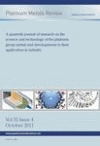-
oa Casting Platinum Jewellery Alloys
- Source: Platinum Metals Review, Volume 49, Issue 4, Oct 2005, p. 174 - 182
Abstract
Comparisons are made between platinum-copper and platinum-ruthenium alloys used for jewellery to evaluate the effects of casting variables. The effects of flask temperatures, investments, and centrifugal speeds on microstructure, percentage fill, and porosity were examined over a range of temperatures. Optimum conditions and materials for successful casting of high quality platinum jewellery alloys, using a Hot Platinum induction melting and casting machine, are described. Suitable choice of investment materials and rotational speeds produced good grid fills with Pt-5%Cu and Pt-5%Ru alloys. Metal porosity was more difficult to control, due to the inherently chaotic nature of the casting process, but casting into a relatively cool mould minimised the probability of bad porosity for both alloys. Pt-5%Ru was found to be successful as a casting alloy when used with induction melting technology. It displayed superior uniformity, hardness and colour, compared with cast Pt-5%Cu alloy.


